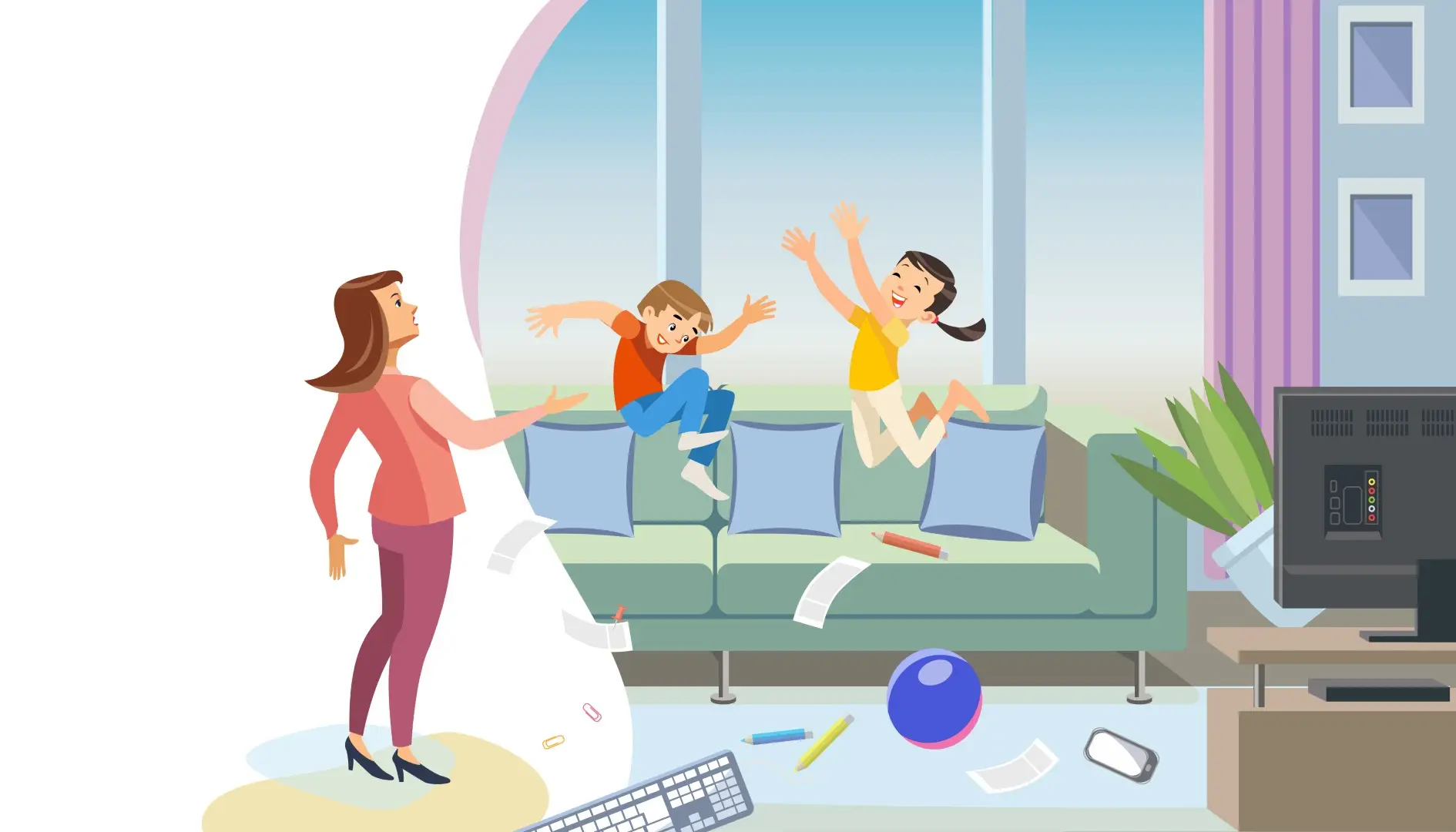Caregivers may believe that corporal punishment will take children’s undesirable behavior under control, which is a complete misconception. We may think that the child learns things through corporal punishment, but what this actually teaches the child is to be afraid, to shy away, and to withdraw.
It is not possible for the children to learn the right behavior, or in other words what we want from them, through corporal punishment.
Let’s take a look at this with an example. You have two children. While your older child is studying, the little one asks for an eraser, and the older brother throws the eraser to him to catch from a distance. The eraser accidentally hits the little brother’s face, and the little boy begins to cry. At this point, you are angry with your older son and you want to give him corporal punishment. If you carry on with the act, your older child may get upset and angry. He may stop studying and no longer want to help his brother.
Your older child did not mean to make his brother cry. This was an accident. However, if you inflict physical punishment due to this behavior, he may develop feelings of injustice as well as negative feelings towards both you and his sibling. On the other hand, the older child still is not aware of the right behavior, that is, what would be better to do in such a situation. From the perspective of the older child, there is a high probability that he thinks that he was declared guilty while trying to help his younger brother. He might even be angry at his brother for starting to cry. In such a case, you can give your older child time to calm down for a while before approaching him. For example, instead of throwing the eraser from afar, getting up and near the little brother to hand over the eraser would have prevented the incident. We may need to buy another eraser if there is only one in the house. To find such solutions, we can talk to our child and think together about what kind of remedies are available.
This is how we can help our children improve in finding solutions to problems and develop right behaviors.
We need to explain this to our children in a calm tone of voice and in a way they can understand.
- If you got angry and punished the child in a rash act, you may approach the child when you calm down, expressing that you had no right to this, and say “I’m sorry”. It is also essential that you talk to your child about the incident during this time. Such an incident may also cause you to feel upset and to regret that such a thing happened. Instead of ignoring your own feelings, sharing them with your child and expressing your regret to the child will help them understand your feelings and prevent the incident from causing any harm to love, respect and trust they feel towards you.
Apologizing will help your children understand that, as parents, you can get angry or give sudden reactions from time to time, as well as help them see that you care for them and respect their personality.

| There are positive behaviors and methods that contribute to the establishment of relationships based on mutual trust, love and respect, which yields better results for the development of the child in teaching children the right behaviors and setting the right boundaries. |
So what can we do to set healthy boundaries and display the right behavior?
A good and healthy relationship between the parents and the children is established when the relationship is based on love, respect and trust. There should be rules in a good and healthy parent-child relationship, which should be clear and comprehensible enough for everyone involved.
These rules should also be consistent and reasonable. The time to return to the house may change in the summer, the winter or when the school is open. Many families set the time for children to enter the house in the evening as ‘just before sunset’.
Clearly defining the rules will prevent the children from getting confused and will make them feel safe in the house they live and with their parents.
Positive Discipline is a method in which children are taught social life skills in a respectful and encouraging manner, in which it is clearly stated which behaviors are appropriate and which are not. The purpose of positive discipline is primarily to establish relationships of trust with children.
| The basis of positive discipline is time and patience. |
Methods That Can Be Used to Practice Positive Discipline:
First of all, this discipline deems it essential to always be respectful to and encourage the child.
- Positive Discipline helps children feel a sense of belonging and significance. It allows children to establish a healthy bond with their parents based on mutual trust, love and respect. When the child wants to show us something, instead of continuing with the activity and saying “It’s very nice” without even looking at it, we can take a break from what we are doing if we have the opportunity and look at what the child is showing us and listen to what they say. If we can’t take a break, asking them to give us some time and looking at what they are showing after we are done will make the child feel significant.
- While setting boundaries, the rules established should be shared with the children directly and clearly. It is very important that the set rules do not change for personal or arbitrary reasons. Rules can be bent when required or in exceptional cases, but the rule does not change according to the situation. There must also be rules in place that parents must follow.
- It is critical for parents to monitor whether the child complies with the rule, to warn the child gently and remind them of the rules instead of ignoring them when they do not comply.
- Setting clear expectations allows our child to understand what we want from them and help them understand what they need to do and act accordingly. For example; the child will not clearly understand what we want from them when we say, “I have been cleaning all day, don’t mess up the house”. Instead, telling the child things such as; “Put your books in your bag after you finish your homework” or “Don’t carry your food around, eat it in the kitchen” will help the child understand what to do as these statements clearly express what we want from the child. Telling the child exactly what we want them to do is much more effective than telling them not to do this or that.
- As in all areas of life, consistency of our behaviors and words is of critical importance when raising children. It is an inconsistent behavior to laugh when the child does something we do not want, such as swearing, instead of saying “Don’t do it”, and then to get very angry when the child repeats the same behavior the next day. Consistency is an essential factor in positive parenting.
- Another point to be considered while raising children is that positive behaviors should be appreciated, not ignored. As parents, we often focus on our children’s negative behaviors and try to change them. Let us remind you that children feel good when they are appreciated, and this good feeling contributes to their development. Children need to feel loved and special. Appreciating your children’s positive behavior when they do something good will encourage them to do it again.
- It is crucial not to hurt the children’s feelings and to allow them to express themselves. It is important for children to be able to share their feelings and experiences with us so that they can develop healthily. This opportunity will also contribute to the development of the children’s speaking and self-expression skills.

Tips for Parents
- Talk to your children about good behaviors and rules. You can even set the rules together.
- Listen to your children and give them time to explain themselves.
- You can also use nonverbal signals when reminding or warning about rules: you can point your fingers at what needs to be done or point to little reminders with our eyes or our gestures. You can do this without getting angry, or even while smiling calmly.
- You can guide the children to the behavior you want them to do: For example; you can gently and determinedly take the child by the hand and take them to their bag and homework and say; “’Come on, it’s time to do homework”.
- If we want the children to brush their teeth before going to bed, instead of saying “Brush your teeth”, you can brush your teeth together with your children every night before going to bed. The children will look up to you when they see you.
- You can speak in a low and gentle tone of voice, not loudly or shouting. Children listen to you when you speak in a low voice as well. They may even have to listen harder to hear you. This is something you can try.
Epilogue
Children, like everyone else, may experience disappointment and sadness. This is an inevitable part of the process of growth for every human being. Our duty as parents is not to prevent our children from all disappointments or to make sure that they never feel sad. Our duty is to protect them as much as we can and help them find ways to survive in the face of their difficulties.
We are allowed to make mistakes. The mistakes we make can teach us a lot. This only shows that we are also human and fallible. Children also learn by making mistakes in a variety of subjects. We need to let children learn about life by giving them a chance to try and fail.


